New Mexico, Northwest
CAUTION: this is a long post. I thought a little about breaking it up, but it’s the same amount of content whether it’s in three pieces or one — so what the hey, here it is. Maybe 100 photos (I haven’t counted them). Oh and BTW — all the photos can be clicked for a full-screen image.
Relax, have an extra cup of coffee, and enjoy…
OFF and RUNNING
After hop-scotching across California and Nevada to visit friends/family, we “blasted” through Utah/Arizona at was for us warp speed (300+ miles per day). During an overnight stop on the shore of Lake Powell (Lone Rock camp), we took a quick jaunt around the back country, letting our new 4×4 “Jayk” (Wrangler JK) stretch his legs a bit. There’s some nice lonely space there to explore.
Then we spent another longish day hauling across the Navajo Nation in northern Arizona. Big, beautiful, and kinda camping-averse. We’ve never yet spent a night in Indian country. My research says they’re not really interested in hosting camping visitors, except in a few crowded, unappealing campgrounds. Maybe someday I’ll find out I’m wrong about this?
On the way to Four Corners, we passed one of the hugest car junk yards I’ve ever seen — about twice the size shown in the photo. Had to have been thousands of vehicles.
Traveling considerably more quickly than our usual glacial rate of exploration, and staying only one night per camp, we didn’t really feel like we were “out there” until we reached New Mexico and slowed down a bit.
And this big, broad State was well worth taking some time to enjoy. But we were a bit limited in time this trip, for we were committed to be back in Flagstaff for the Overland Expo mid-May — so we restricted our wanderings to the northwest part of the State.
We were pretty road-weary by the time we approached Shipwreck Rock, and we drove through the area without a visit, a shame. We’ll have to get back there and see it in person. Here’s a USGS pic from the wiki, of what we missed.
Settling into Cottonwood Campground (the best of the Navajo Lake offerings IMHO), we rested up and enjoyed the cottonwoods — hoping that the brittle boogers wouldn’t drop a branch on our erstwhile Howie.
We heard a related story on this topic —
///
A man and his son had visited the camp, and stayed in the same campsite, for the last 19 years. Traditionally in the same campsite, they would camp, fish, and have good times together. They were really looking forward to their 20th anniversary, but some minor issues at home delayed their departure, and they arrived a day late at their campsite.
When they pulled up and parked, they were surprised by an enormous cottonwood limb lying directly across the pad where they always pitched their tent.
According to people in the camp, it had fallen there the previous night at about 2AM.
Morals to this tale:
-
Watch out for those pesky brittle trees
-
Your number is not up until it’s up.
///
Next day, we day-tripped 80 miles south into the Bisti Badlands Wilderness Area.
BISTI
This is a large area (20 miles in its long dimension) of “badlands”. It’s in a flat, sere countryside, with no “overlooks” to give a preview of what’s to come. It’s on first glance no more than a plain plain.
If you’ve never seen a badlands area, it’s pretty striking when you do get into it. The earth is eroded and exposed, but doesn’t seem to harbor a spec of life. In a casual glance, there is little or no sign of critters or plants — it’s by all appearances a dead landscape.
Of course, there is almost always some life to be found, even in these extraordinary lands, but the impression of a moonscape remains. (One commenter on my Facebook post said “where’s the Rover?”, alluding to the Martian appearance.)
The other “bad” part of “badlands” is that there’s usually no water. Hiking through these areas is a profound desert experience. But obviously, it took both wind and water to perform the erosion. Twice each year, the rains do arrive, and continue their inexorable sculpting.
We hiked only a tiny portion of the big expanse, maybe 3-4 miles out-and-back.
It’s a wilderness-designated area, so no vehicle access. But what we saw was worth the hike, and of course the desert space and stillness are always their own rewards.
ANGEL PEAK
We’d read about Angel Peak in Marianne Edwards’ excellent Shunpiker’s Guide (highly recommended), and we decided to move camp down that way for a closer base for further exploring.
Wow, what a find. The Angel’s Peak scenic area is a noteworthy Badlands region in its own right, and we were delighted to find this spot. A short, rough, 6-mile dirt road took us to free camp sites (with restrooms!) and a fantastic array of criss-crossing roads woven through the gorgeous scenery. Here’s an overview from Google Maps Earth view:
Here’s the camp’s-eye view of the peak (and a sister):
And a telephoto of the secondary formation, with a couple of camp neighbors out for a hike.
From the opposite side of camp, a butte whose name I didn’t learn, 20 miles across the plateau.
And on the way in to the camp, there are many pullouts with outstanding views, where camping is also allowed.
I should briefly mention that NW New Mexico, especially the region around Farmington and Bloomfield, is a natural-gas bonanza. And it is being aggressively exploited, with well-heads incredibly densely packed — I’d guess as close as 1/4 mile apart, or even less, for miles and miles. Satellite views look like the land has been riddled with buckshot.
The good news is that they are working to minimize the environmental and visual impacts of the drilling and pumping. All of the installed equipment is painted to blend with the terrain, and a good job it is. The well-muffled pump motors run on their own well gas (no diesel, no spills), and they can’t be heard more than 50 yards away.
The even better news is that the wells are mostly scattered across public (BLM) land, and all of those service roads are available to you and me for exploring. Here is just one valley showing a few of the tracks.
Needless to say, we put Jayk to work, big time. First, we climbed up over a small knoll about a mile from the end of the camp road – – –
– – – and then we ridge-crawled down a thousand vertical feet, into the valley of the Badlands below the Peak.
This is the track we just came down…
The service roads went everywhere, and we had to be really attentive to our offline maps (thanks Osmand). We stopped to chat with a local worker, a gas-pump mechanic who helps keep the wells producing. Nice guy, and he gave us some pointers about which roads to take.
He explained the ubiquitous tiny yellow flags that dotted the roads and berms everywhere we went. They needed them to mark the pipeline locations, so that the road maintenance crews wouldn’t blade up the pipes.
In general, the roads were pretty easy 4×4 or even 4×2. Here, a washout was working its way through the byway. It was an easy drive-around — until the next rain. But sometimes, these washouts will undercut a road, invisibly, and you only discover them with the weight of your wheel(s) plunging through. Ask me how I know this.
For several hours, we roamed up and down through the Badlands. The characteristic erosion leaves formations of infinite variation and beauty around every corner.
At one point, we worked our way down a canyon and around a turn, and got a worm’s-eye view of the beautiful Peak we had admired from camp.
The capricious nature of cap-rock style erosion creates unique sculptures, right in the midst of “ordinary” landscapes.
For our lunch stop, a dry sand-wash and wanna-be arch (someday) made a pretty setting. The sand was amazingly firm, and we left hardly any tracks in it.
As the afternoon thunderstorms began to mount, we worked our way back up out of the badlands canyons, and returned to our cozy camp.
We used our camp to relax, explore, and make day-trips — all as usual. Really nice spot.
CHACO CANYON
I last saw Chaco more than 30 years ago; Karin, never. People describe it too casually as “Indian ruins”, but to compare the structures at Chaco Canyon to any of the other Puebloan dwellings is to compare The Ritz to Motel 6.
The scope is enormous, with the entire valley occupied to some extent. Walls are thick, tall, sturdy, meticulously sculpted, and still standing 1000 years after being built.
Everything was hand-built. The Puebloans had no beasts of burden (horses, oxen, donkeys) and didn’t even have the wheel for transport. Construction took place over several hundred years.
Logs for lumber and roofing were hand-carried from forests over 60 miles away. Scores of 10-man teams lashed cross-trees to logs, then picked them up and carried them a few miles. Another relay team would take the handoff, and the original team would back-track for another log.
The extent of the Chaco installation represented the cultural and organizational hub of the entire Puebloan existence. Many of the functions were far more than living or storage, with many spiritual centers.
Some of the buildings have been buried and not uncovered. Others have been damaged by rock falls. Even as rubble, the ruins are incredibly impressive — but can you imagine what those structures must have looked like in their day, viewed by a technologically primitive people? The archeologists are still mostly guessing as to the cultural aspects, and the politics and management structures needed to create such a massive presence with only manpower as a resource.
In addition to the ruins, some of the natural formations are nearly as striking…
Somewhat reluctantly, we left our blissful Angel Peak campsite and headed down toward the Santa Fe national forest. We wanted to see what the highway 4 Jemez Scenic Byway was like, and we weren’t disappointed.
JEMEZ and BANDELIER
Highway 4 runs from US-550 in the west over to NM-502 in the east, traversing the Jemez Mountains of the Santa Fe forest. It’s a really nice drive/visit for any kind of vehicle, and there are sights and features all along the way.
I’m not sure why big rocky promontories are often named “Shipwreck” or “Ship”, but Jemez has its own version. Very pretty, and a striking contrast to the forested mountainsides.
As luck would have it, our May 2019 visit was preceded by substantial rain, and the cottonwoods were greening up in almost a fluorescent splendor. These splashes of near-iridescence were seemingly everywhere, but of course were actually present only along drainages and waterways.
The Byway is ‘scenic’ indeed, with lots of color and formations — not to mention a green, healthy forest full of campsites and hiking trails. The USFS now is issuing road-use maps (free), and the maps designate areas used for “dispersed” camping — no facilities, go self-contained, pack-it-in / pack-it-out. Just our kind of camping. There are literally hundreds of dispersed sites in the Jemez. We picked a nice one near the top of a ridge, and even had a couple of bars of 4G!
We took a side-trip on the side-road (485/376 at the southwest end) that goes through the Gilman Tunnels. It’s a blend of pavement and dirt that Jayk the Jeep took easily in stride. The tunnels are an old pair of single-lane holes in the canyon rock walls, with the road following the Guadalupe River canyon. For me, the quaint old passage evoked many thoughts and images of the wagon/stagecoach days.
One of the reasons that the Santa Fe forest is healthy is the increasing management. Many, many places showed the “harvesting” of dead, down, and burned wood. This clears the forest floor and prevents the accumulation of the deep duff which fosters devastating fires.
We also saw frequent plantings along the roadways, new trees to replace the lost ones. With 90% of all US forests gone, I’m glad to see that forest management is a high priority. They don’t always “get it right”, and mistakes are made — but at least they are paying attention. We really need to take good care of what’s left.
In the middle of and to the north of the Byway, a huge treeless expanse interrupts the deep, tall forests. This is Valles Caldera, a million-year-old volcanic caldera that is about 14 miles wide. Elk are often seen grazing here; we found quite a few in the early morning and late afternoon hours.
Near the eastern extent of NM-4, Bandelier National Monument is unique in a land where Indian ruins are commonplace. Puebloans made these habitats by taking advantage of the natural caves in the soft tuff cliffs. They would dig holes in the cliffs to support roof poles, and extend the caves outward, creating a distinct hybrid “building”.
One of the old cliff caves is open to the public — but you can only get there by an arduous path up long wooden ladders, built to the Ancestral Puebloan style. It’s a pretty cool “hike” — especially at 90F. Phew.
Karin and I were doing pretty well scurrying up and down the ladders. Others, not as quick. One slender young college gal was looking at me kind of strangely; she smiled ruefully and commiserated, “The only exercise I usually get is walking from my dorm to my class. This is harder.” <grin>
TAOS and the RIO GRANDE
After Bandelier, with our (short) recon of highway 4 completed, it was time to head over into the Taos area. Lots and lots of map research showed a string of promising camps along the old river of fame and fable, the Rio Grande.
We pulled off of NM-68 onto NM-570 and started paralleling the famous old river. Only a few miles north, we settled into Arroyo Hondo, with a nice flat campsite just 100 feet from the swiftly flowing water.
The Rio Grande was the region where many of the Puebloans migrated to after the 50-year weather debacle that drove them out of the Four Corners area (Mesa Verde, Chaco Canyon, etc.). So we were happy to find a good camp and enjoy the land around this classically Western area. It being a weekend when we arrived, we found rafters, paddlers, and SUP-ers out in force, enjoying a placid section of the river.
Our first quick stop was not so much a wild or old-West experience as much as it was a glimpse back in time: the Classical Gas Museum on NM-68 (27 miles south of Taos). What a hoot, and how surprisingly nostalgic for my 72-year-old brain.
A vivid reminder of when my dear Mom thought that 36 cents a gallon for gas was really pricey. There isn’t even a place for a dollar digit in this old mechanical pump.
And of course, even earlier there were the “fish-bowl” pumps. You hand-pumped gas up into the glass jar until it showed the amount you wanted; then you simply let it drain into your gas tank.
The Museum is right on the highway, but it’s easy to drive by quickly. Turn around and come back. You can even buy antique (real antique) souvenirs of the by-gone era, old brands that are only familiar to my generation. Signs, lights, containers — pick your memento.
Roaming around the Taos area presented many different glimpses of this eclectic part of New Mexico. Wild or weird, we never knew what was next.
This is the Rio Grande Gorge bridge, just west of Taos on US-64 — longest suspension bridge in the USA.
And THIS…. this is some kind of ornament, or statement, or architectural voodoo doll. We don’t know or understand, it just sits on the front land of a small ranch just south of the Gorge bridge.
We always try to get out and hike (or at least walk) every day. It’s good for body, mind, and soul. Sometimes we see great stuff; sometimes we get a great workout; sometimes we chat up interesting people; and sometimes we just have a nice walk.
Hiking around different places, you literally never know what to expect. One day, a 4-foot-long darter snake (non-venomous) flashed under my feet at warp speed. After scaring the crap out of each other, the snake scurried up a small tree and “hid”. He must have felt safe, and he stayed there long enough for me to get a few good shots.
CARRIZOZO and the VALLEY of FIRES
After several days exploring the Taos region, we decided to go have a look at the Elephant Butte reservoir/lake, down near the lowest part of the area I’m calling “northwest New Mexico” (just north of Truth or Consequences). But it was a bit far for one day’s drive, and we decided to stop at Carrizozo on the way.
The town itself sprang up with the advent of the railroad, and boomed for a while with lumber and mining activity. But those industries collapsed. They were eventually replaced only by tourism, in the mountains to the southeast, and Carrizozo dwindled and nearly died.
Today, the town consists mostly of shuttered businesses, but there are a few art shops and a decent diner remaining (at the intersection of US-54 and US-380), and an overall area population of about 1,000.
The “Valley of Fires” refers to an old lava flow that starkly marks the otherwise bland expanse of desert scrub. It’s a pyroclastic flow, produced from vents and not from an eruption. The flow is estimated at about 5,000 years old, which places it well within the range of primitive inhabitants (11,000 years). The name may have been handed down by oral tradition, who knows?
As fortune would have it, the camp that we had picked was spang in the middle of the lava flow, and even had a “nature walk” that toured some of the more interesting formations of lava. It was a real treat to walk out of Howie and visit the craggy chunks of stone.
It was a chill, blustery day when we took the walk through the lava flow. The sun canopy on the ridge speaks of warmer times, when temps exceed 100F mid-day, even at the 5,000′-plus elevation.
The moist weather was bliss for the cacti, and they bloomed beautifully.
Karin spotted this little horned toad hiding out in a prickly pear. Can you see him? (Hint: it’s mostly his rump that’s in the picture.)
I’m not sure which is more harshly beautiful — the ankle-breaking pahoehoe (ropy) lava, or the cluster of miniature barrel-cactus with its late-Spring blossoms nestled among the treacherous spines.
HOUSING? One of the other more remarkable features of the area is “Valle del Sol”, a real-estate venture out in the vast expanse of the central plain. We drove around the development, amazed at the amount of money that must have been invested for water and power underground utilities across miles of desert — and the tiny number of dwellings that had taken advantage of it.
At the entrance is a big traffic circle (with no traffic), and some nice landscaping, including these excellent iron sculptures.
Scattered sporadically around the huge flatland are a handful of middle-scale dwellings. I presume these are “early adopters”, who may or may not be questioning their wisdom.
In the middle distance, a private ranch sits outside the development. Can’t help but wonder what they think about all of it.
The tract is 30 miles from the nearest sizeable town (Ruidoso), and it’s hard to understand its appeal. Maybe pricing? Don’t know. But there it is, just waiting for the next enthusiast to buy a plot of land in yet another middle-of-nowhere.
SMOKEY and SKIING — A day-trip took us past the ski/tourist town of Ruidoso, a vast contrast to the faded Carrizozo. Vibrant and thriving, with tons of up-scale shops, chalets, and services, Ruidoso was both striking and somewhat annoying. We kind of like the wide-open spaces, and a ski resort town just ain’t that. But they did have auto-parts stores and a good restaurant. We counted our blessings.
On the way back to camp, we stopped by the Smokey the Bear museum. We didn’t know that Smokey came from New Mexico, and we learned a bit about this charming old icon/legend. I really wanted to buy a keepsake, but none of the paraphernalia are in production, or for sale — so there they stayed. My dreams of owning a Smokey the Bear lunchbox are on hold for now.
ELEPHANT BUTTE LAKE
After our surprisingly pleasant “stopover” near Carrizozo, we pulled up stakes and headed for Elephant Butte, our most southern visit for this trip. Having researched the area by map and Internet, we expected a somewhat crowded swarm of BLM and State Park camp sites. Well, we found the swarm, but not the crowds. After a few tentative explorations, we settled onto a high bluff above the Lake, with a wonderful view out Howie’s front window — accompanied by some Mothers’ Day flowers for my sweetheart.
Exploring around a bit, we were treated to the water-side greenery and afternoon thunderheads…
We “followed the green”, and got down near the water…
…which turned out to be the joint between the Rio Grande and the Lake.
That evening, we inflated our kayak and loaded it onto Jayk for an excursion the next morning.
Launching out into the lake early, we had a perfect, balmy, windless kayak run. There wasn’t even any current, except for a brief spell right where the Rio Grande flowed into the lake from the north.
The Lake (and the Rio Grande) are part of the Central Flyway, critical havens for migratory waterfowl. We got to see some pelicans and cormorants that we’d ordinarily expect by the ocean near our California home. [To be precise, these pelicans don’t live along the California coast; they are the White Pelican, and they also sport the most peculiar “beak bump” during Spring mating season.]
We figured, from the flurry and gulping, that there were a LOT of fish in the lake. The birds (and later, the fishermen) were pretty busy.
It was still pretty early in the day, a bit cool, and the cormorants were “doing their thing”, sun-bathing by spreading their wings. We’ve seen buzzards and other dark-colored birds do this as well.
As we paddled around the northern extents of the lake, we found really brushy spots. We learned that the lake level had been raised only recently, flooding a lot of overgrown areas in several feet of water or more. Our Sea Eagle 385FT uses only about 8″ of water, so we were golden.
Paddling back toward camp, we got this great view of Howie, perched on his hill like some kind of Feudal Lord, master of all he surveys. We seem to have a knack lately for finding really cool camps.
That evening, some late-afternoon storm clouds blew through, and gave us this pretty rainbow for a good-night gift.
We spent a few days just relaxing and poking around. It was obvious from the worn roads and too-frequent litter that this area was more heavily occupied in other parts of the year. But for us, in mid-May, it was nearly empty, and grand.
Time marched on, and we had to get going to make our “date” in Flagstaff. Off we went, to our last stop in New Mexico — the eerie, near-mystical telescope array known as the VLA.
The VERY LARGE ARRAY (VLA)
There’s a perfect reason why this radio-astronomy site was used in movies like “Contact” — it’s other-worldly in appearance. It’s also purely impressive, both scientifically and logistically.
But first — you have to get there. It’s remote enough, 40 miles west of the remote town of Socorro. But we had to go it one better and approach from the south, along the old NM-52 route. The last 50 miles of this road are heavily washboarded dirt, and we were feeling like Howie was going to be a parts kit before the journey was done.
The beginning of Howie’s nightmare (and ours), where NM-52 turns from pavement to dirt…
…and a seemingly endless stretch of the 50-mile torture…
Despite the harsh ride, there was a grand charm to the remote ranch country we drove through. On the occasional smooth stretches, we could really enjoy ourselves. Every few miles, the current ranch would sport a spiffy gateway and nicely-done marquee — this one is showing off the Limestone Outfitters spread.
And, being mostly suburban folk, we were always amazed to see mailboxes way to hell-and-gone in the middle of nowhere, like Coyote Flats’ unpretentious #235. No wonder the USPS is always going broke.
Suffice it to say, the next time we visit VLA, we’ll either have better suspension, or we’ll take the “civilized” route in from the north (via US-160).
The VLA is placed in this far-flung part of the world precisely because it is so lonesome. There’s very little radio-frequency activity to inject noise into the faint signals being sought. It’s also very high and very dry, which also helps in reception.
How does it work? There are 27 antennas (plus one spare) that are positioned on three radial stretches of railroad track. The antennas are enormous, over 100 feet in diameter, and they can be moved only at a maximum pace of 2mph. And get this: the antennas can be positioned anywhere from snug together, to as much as 11 miles away from the center hub. The net effect is a radio-telescope with a 22-mile-diameter “lens”.
Knowing the technology, understanding the nature of the interstellar information that is being gleaned, and seeing the mechanical implementation of such a prodigious project, always raises the hairs on my neck. This (second) visit to the VLA was no exception.
I can’t help wondering what they’re all going to “see” next. Of course it’s a demonically dense task. The supercomputer responsible for data processing functions in the quadrillion operations-per-second range. And the VLA is a much-sought resource; you can’t just walk up and “peer” into space on a whim. In fact, only twice a year are bids reviewed, and only the highest-level projects are allowed time on the telescope.
Leaving the VLA, it was again time to make tracks westward. We had tickets for a wonderful travelers’ convention in Flagstaff, the Overland Expo.
EXPO — We always try to make time to attend the Overland Expo (Flagstaff in May), a fantastic collection of “overlanding” products and enthusiasts. “Overlanding” is the process of traveling across various lands, “camping” (not motel-ing) along the way. The Expo is something we have been attending regularly for many years, and we always enjoy it. But that adventure is indeed for a different post.
On the long, 4-state drive back home, we took a short detour on old Route 66, just east of Kingman AZ and north of I-40. This is a pleasant, leisurely escape from the frenzied, truck-laden Interstate, and it gave us a chance to enjoy the nostalgia of the old Burma-Shave signs.
STILL CURIOUS?
In previous posts, I’ve used this space to put links to websites related to the various places we’ve visited. Frankly, it’s been a TON of work, and it’s not clear to me that anyone uses the links (or for that matter, even reads to the ends of my posts <grin>).
So, as of this post, please feel free to let your keyboard do the walking. You can enter any of the keywords I’ve used as paragraph headings, and get lots and lots of hits to the topics that interest you most.
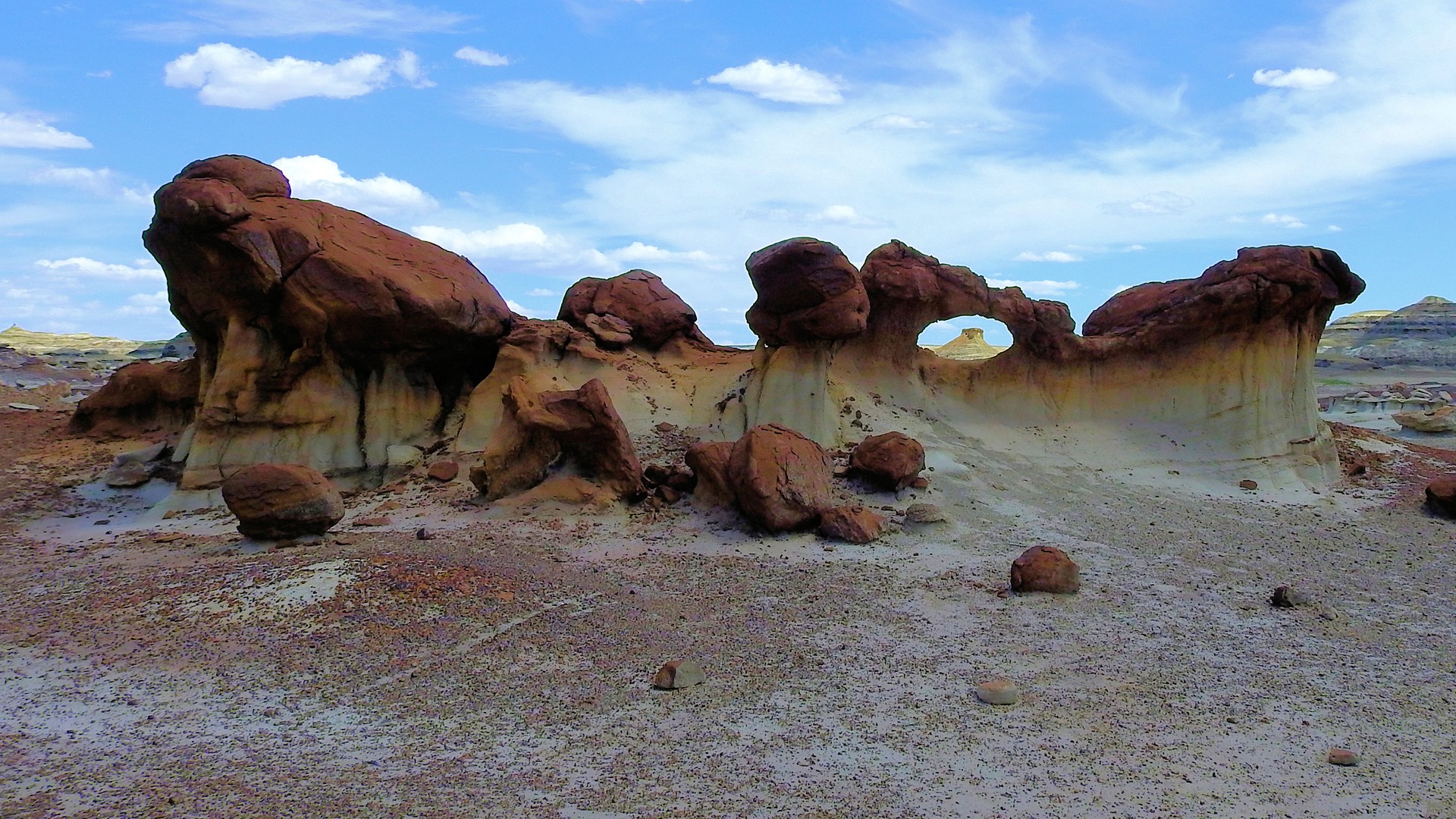
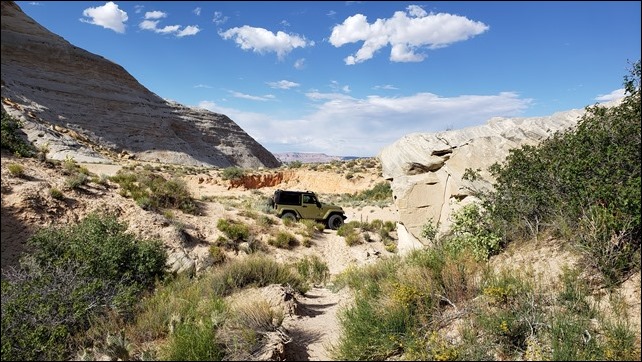
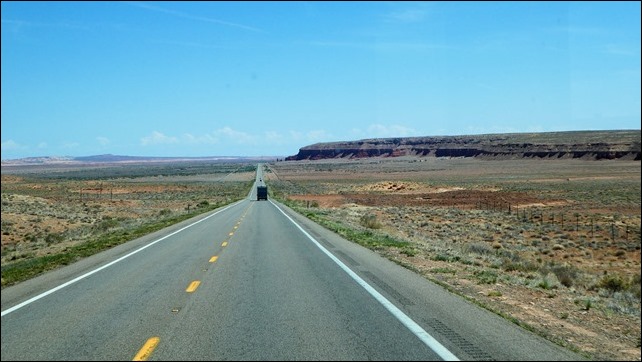
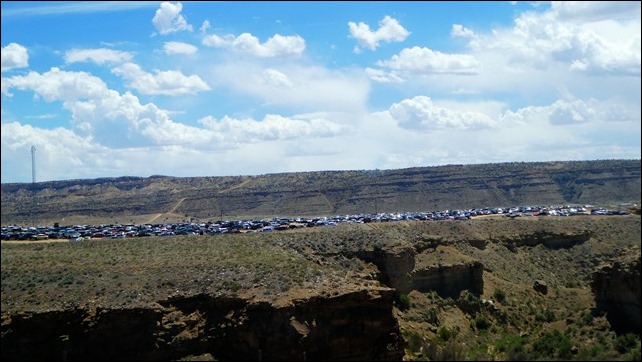
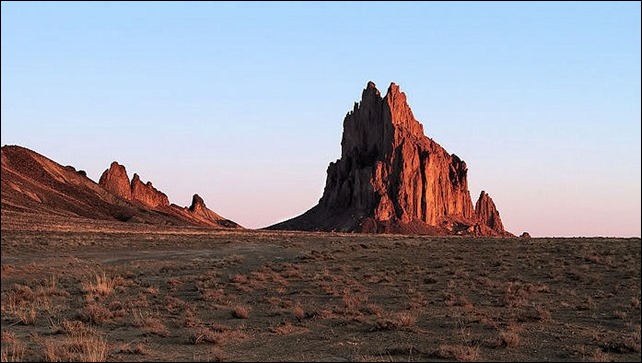
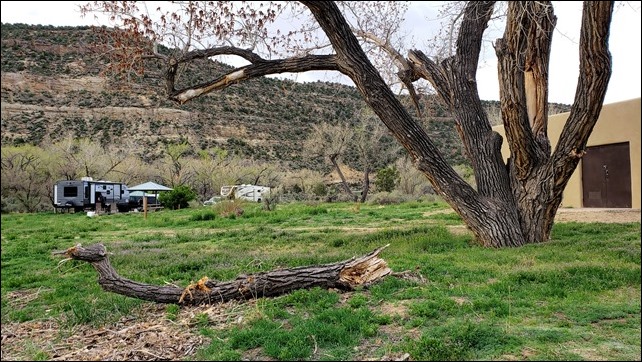
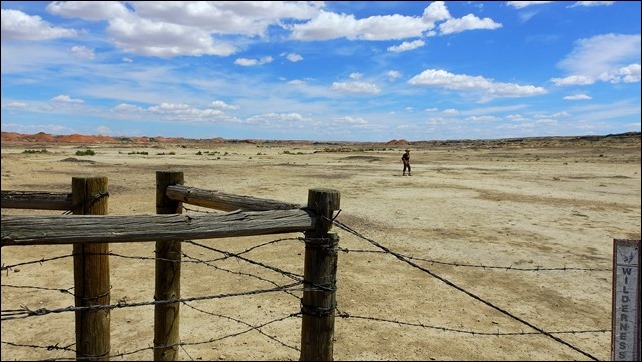
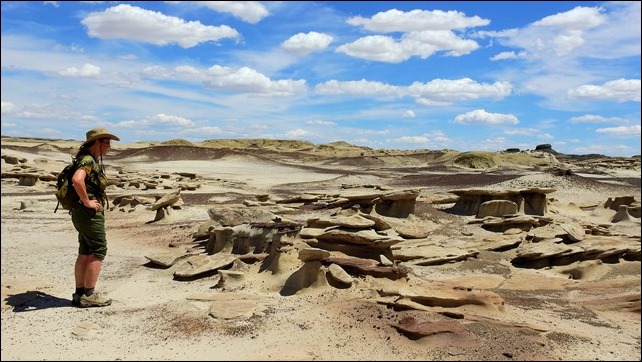
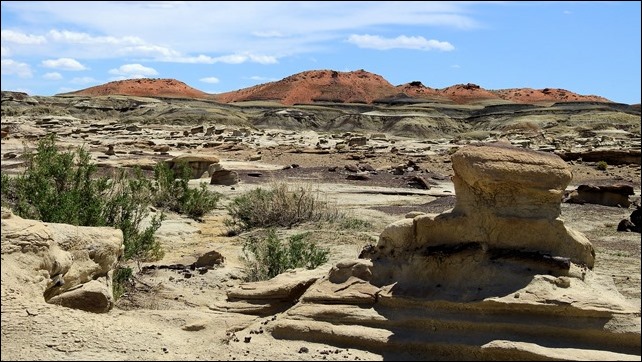
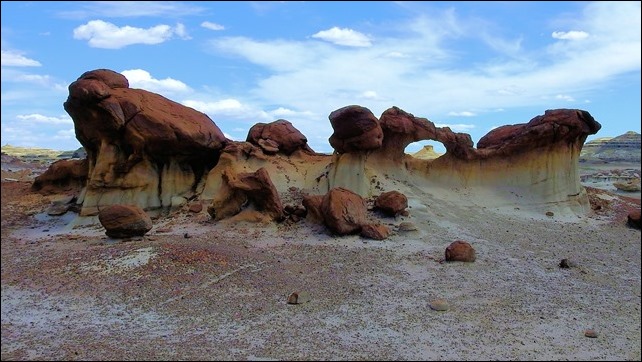
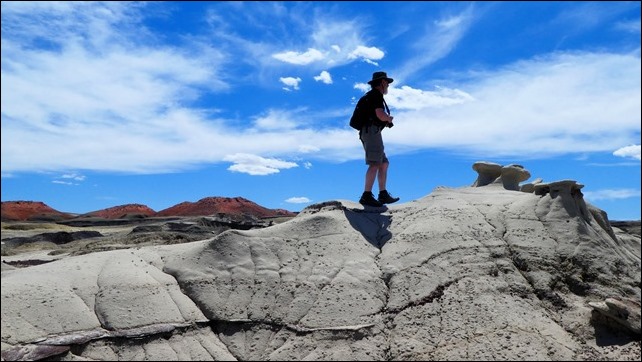
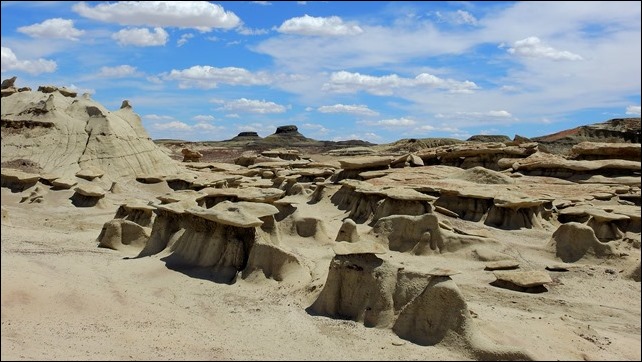
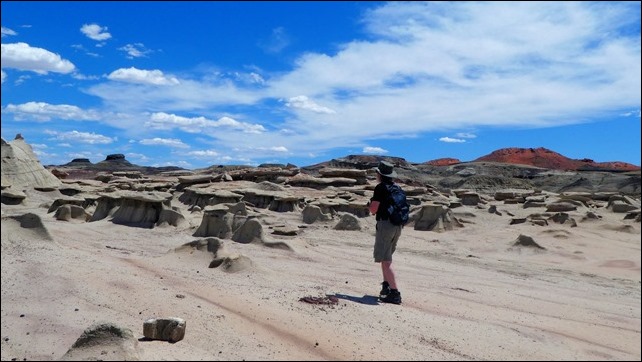
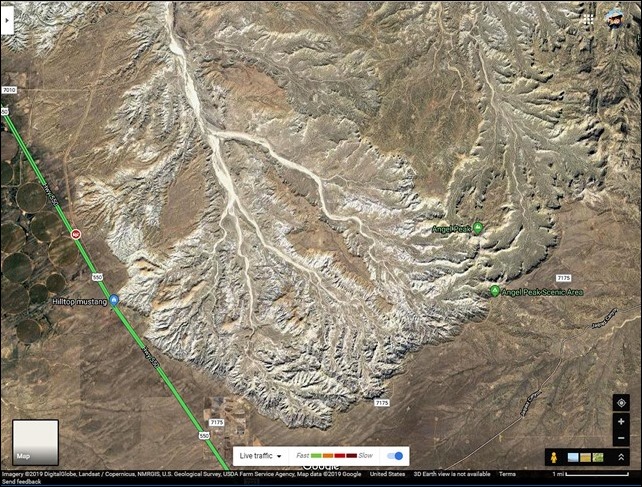
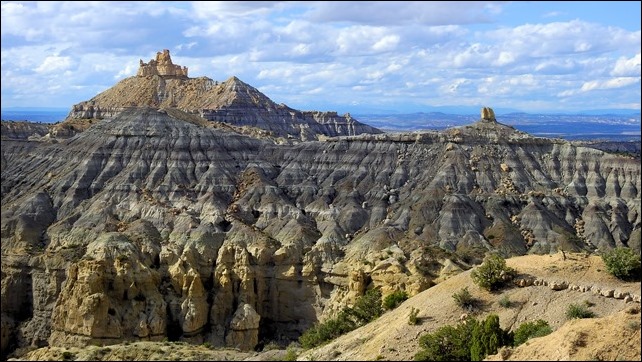
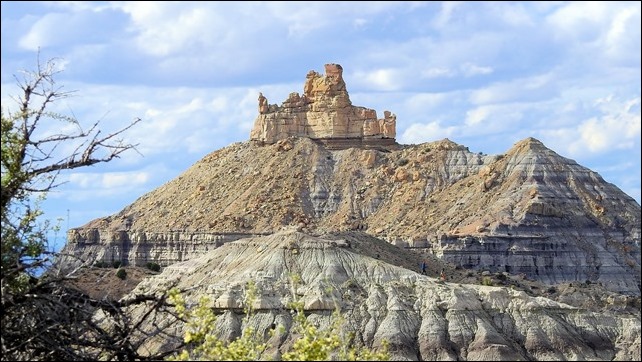
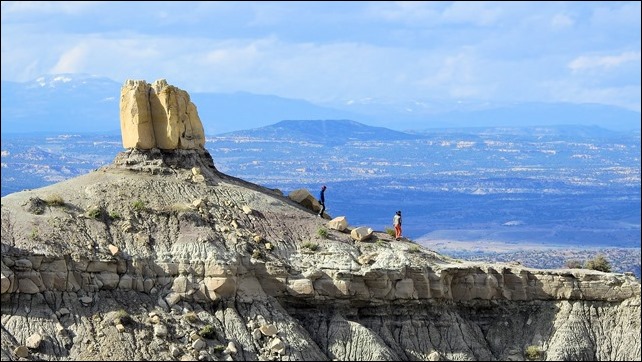
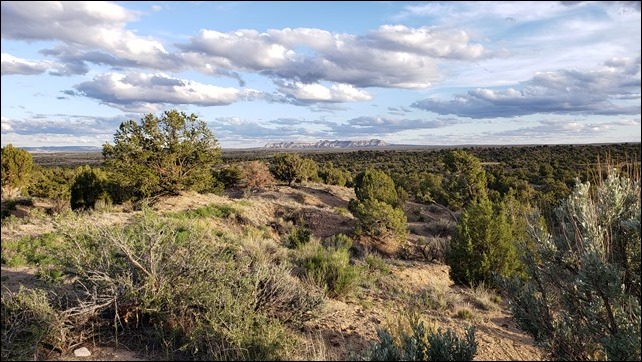
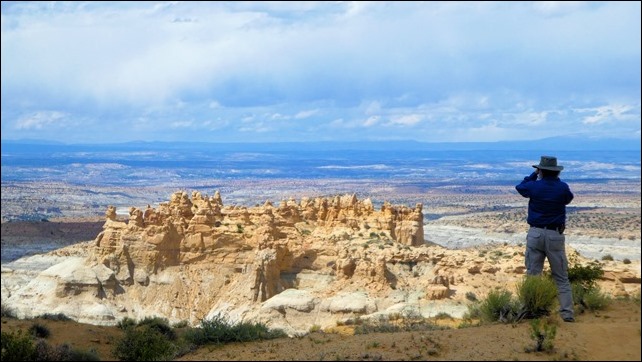
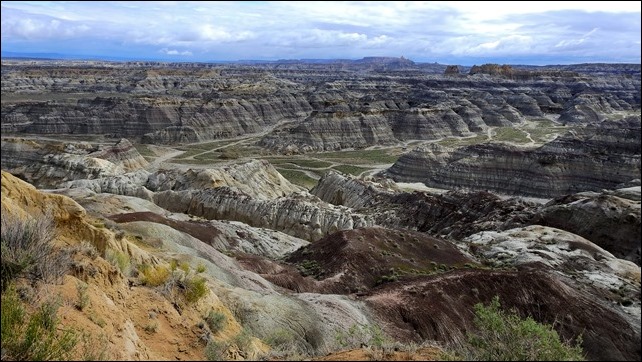
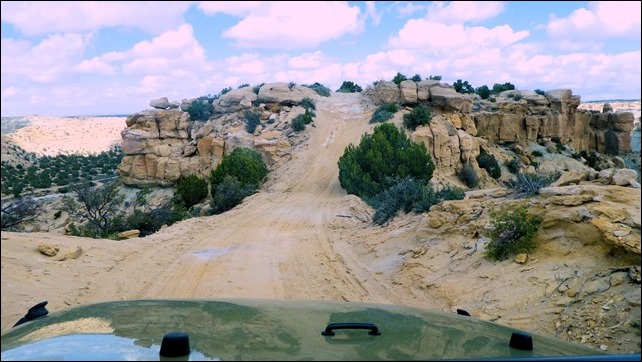
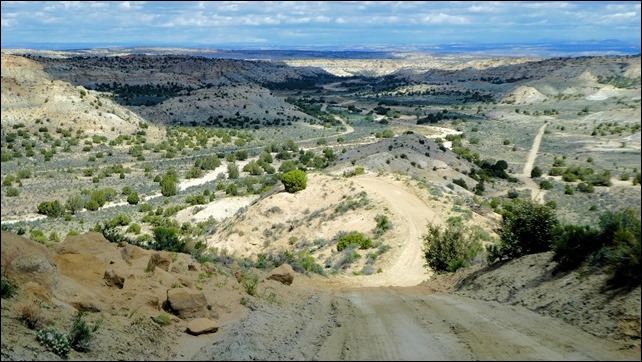
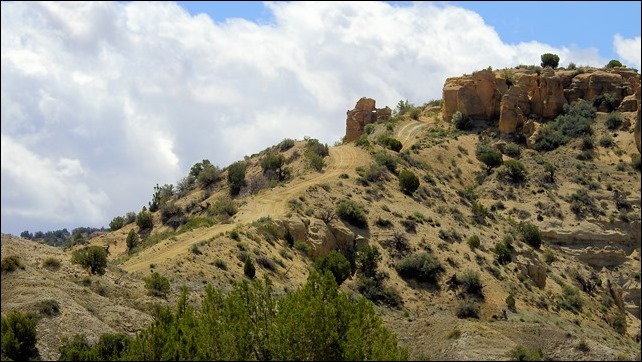
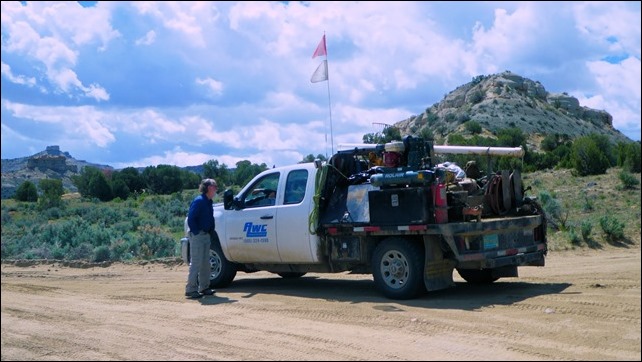
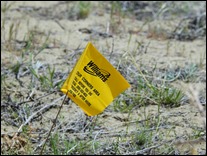
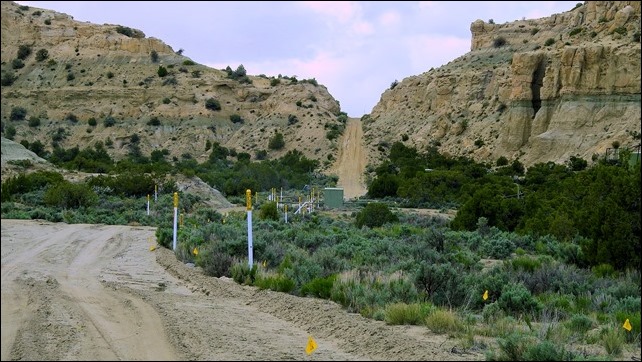
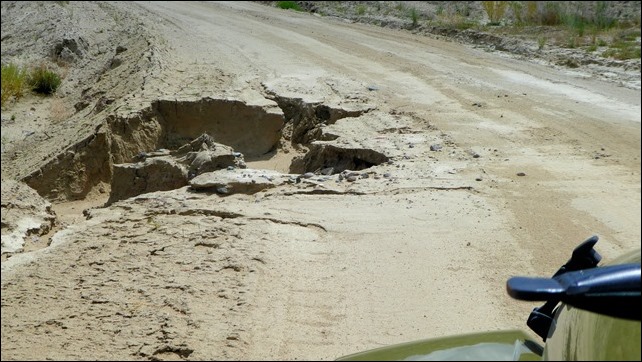
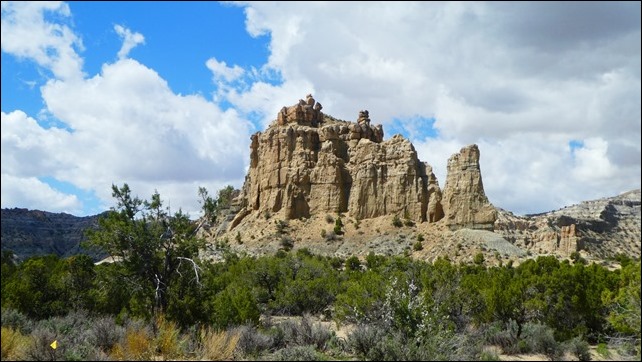
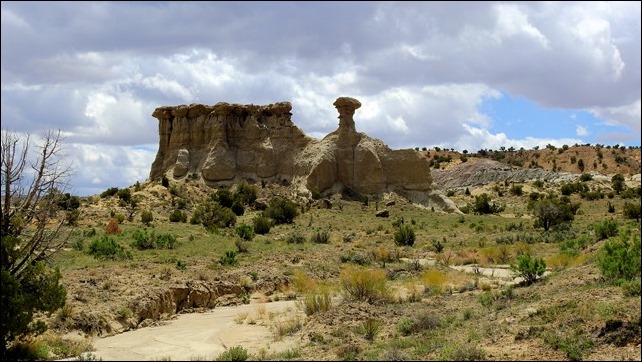
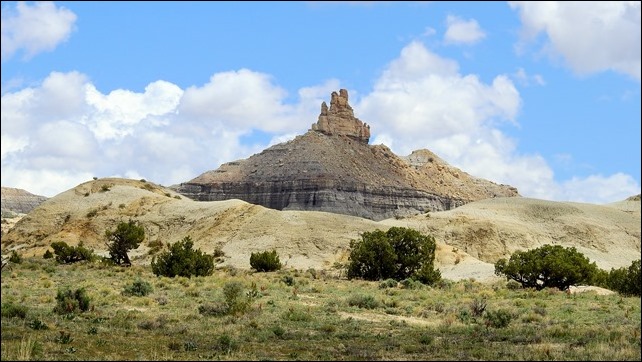
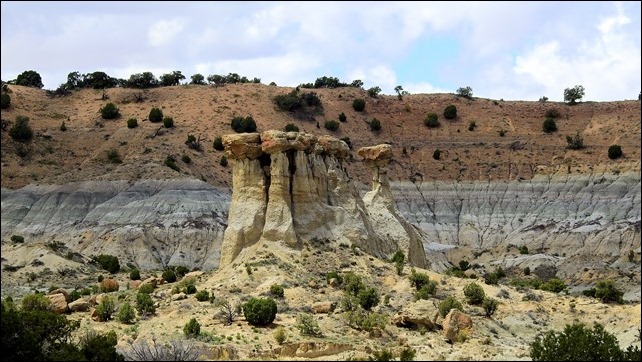
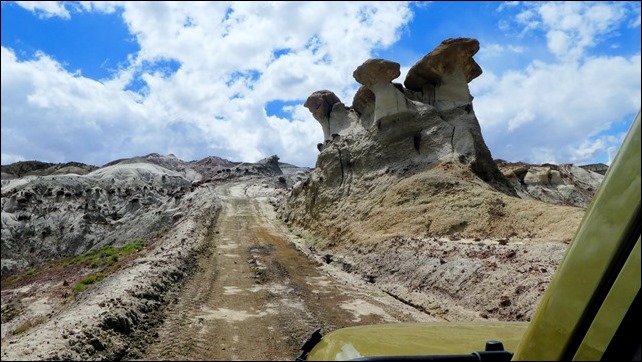
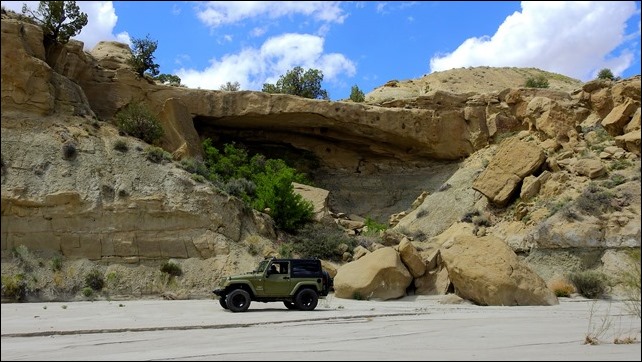
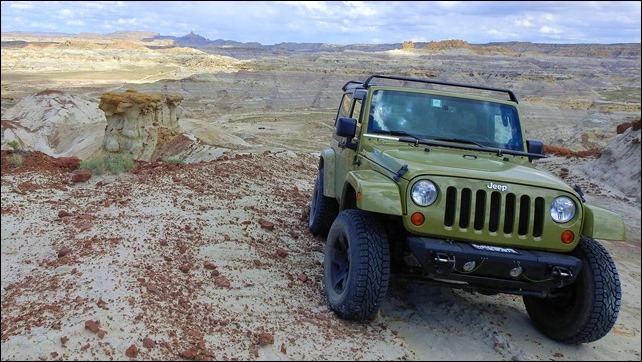
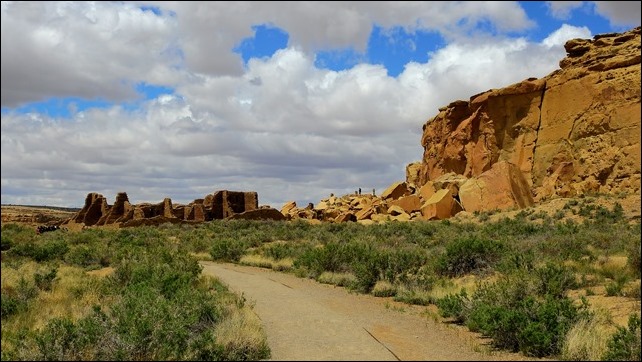
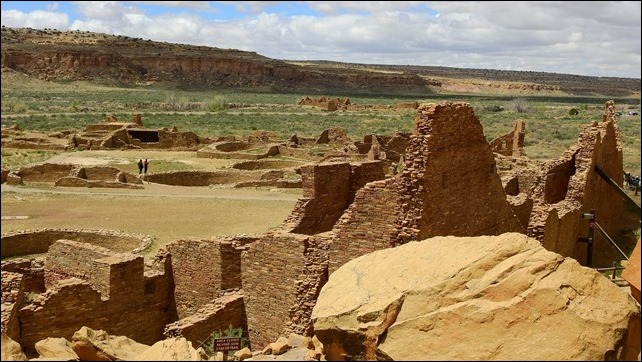
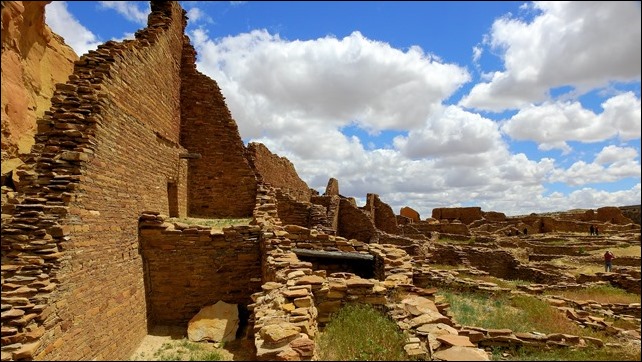
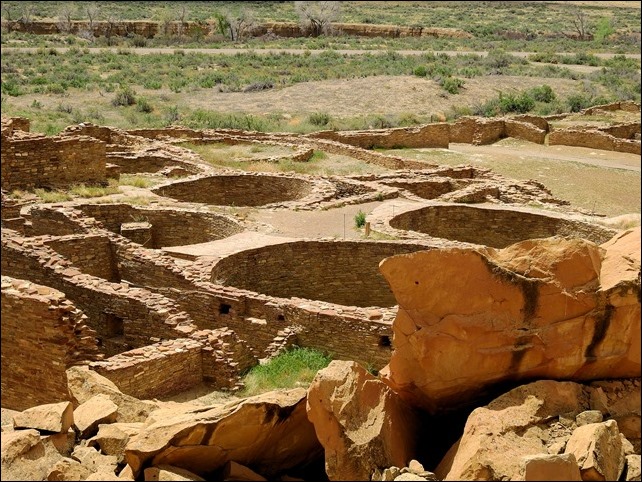
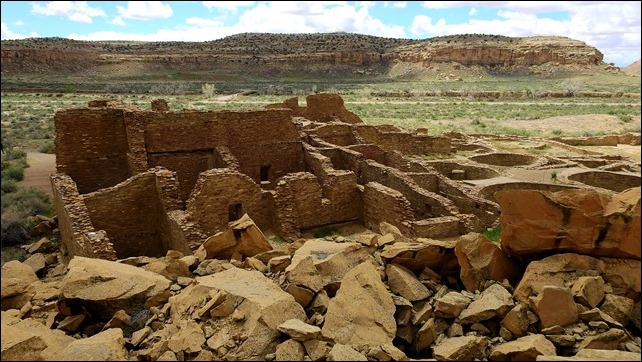
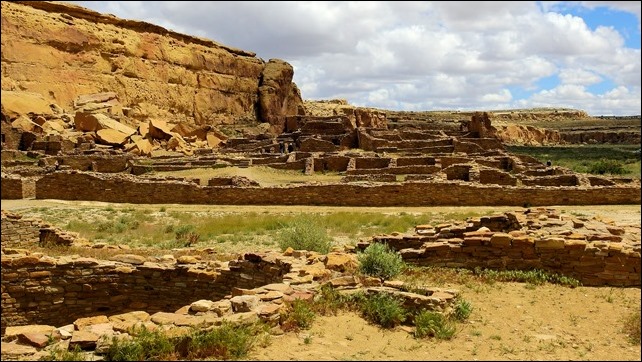
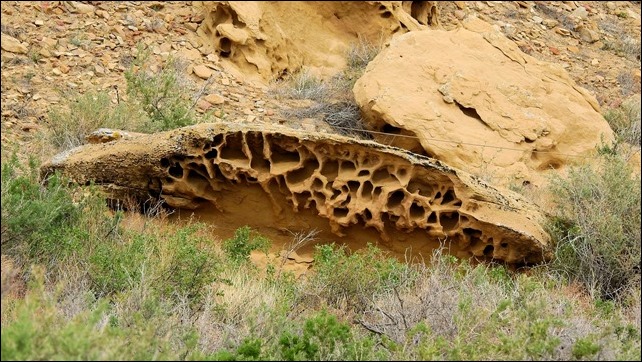
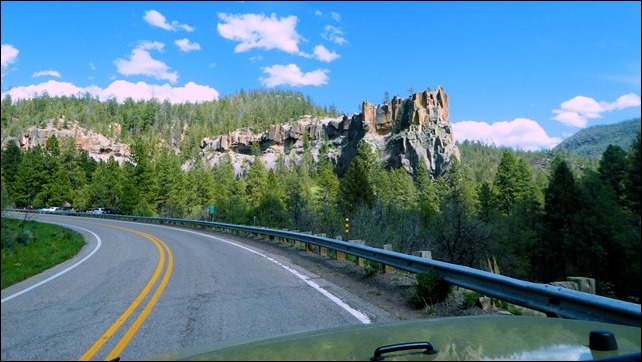
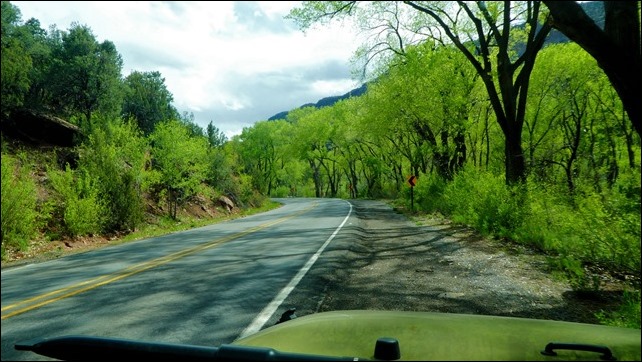
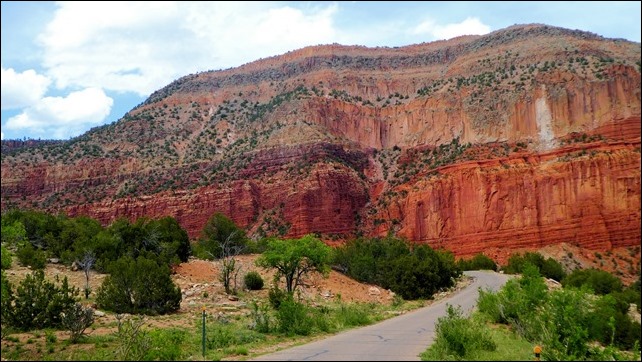
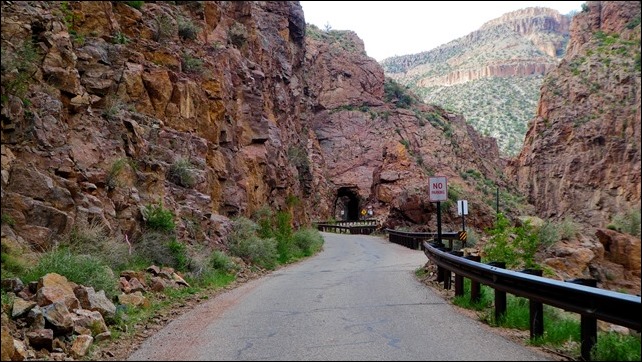
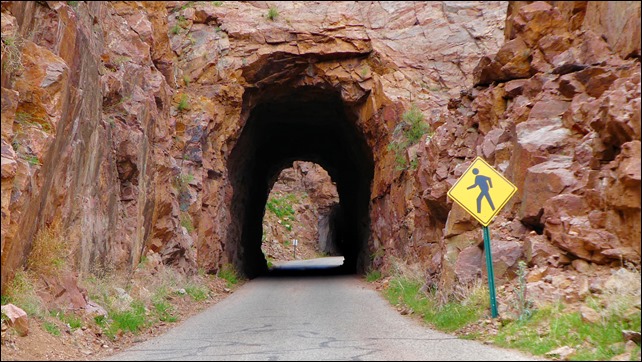
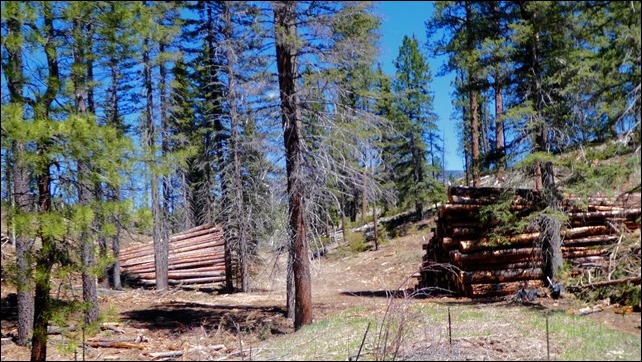
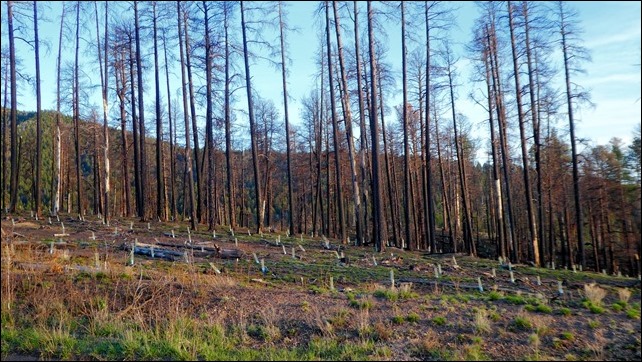
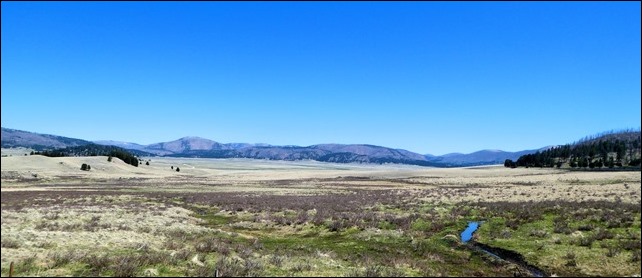
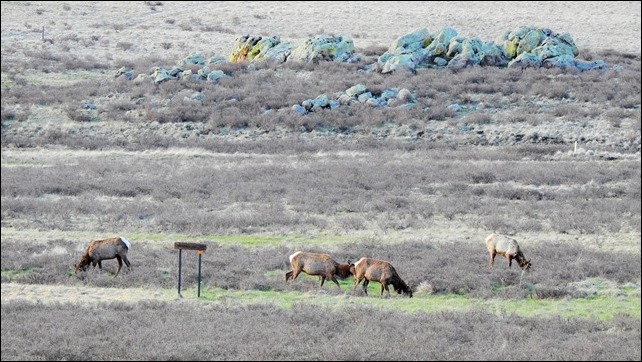
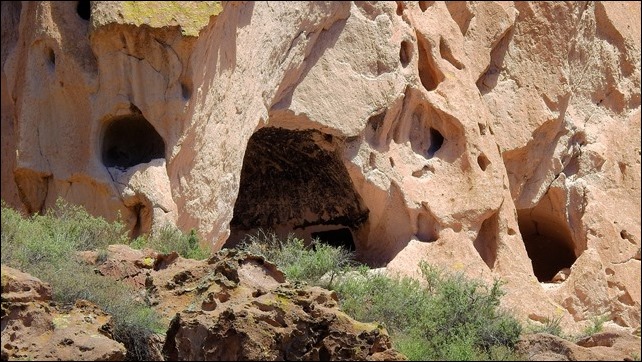
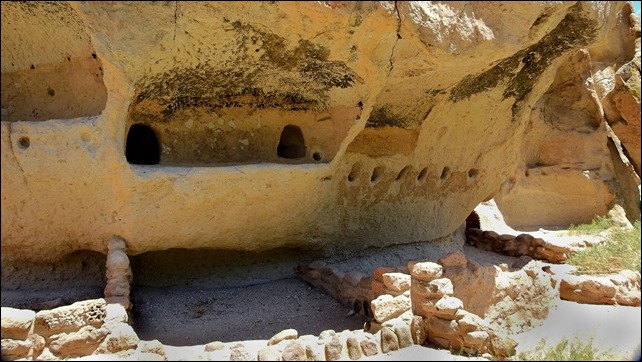
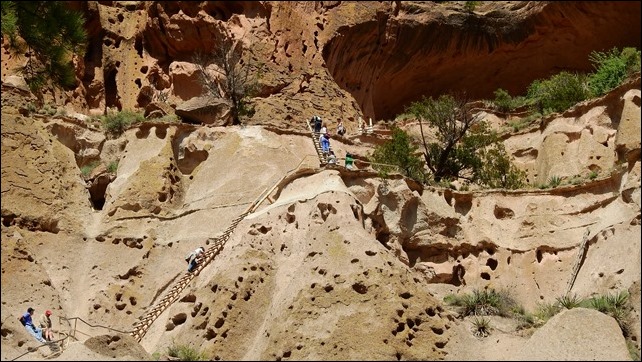
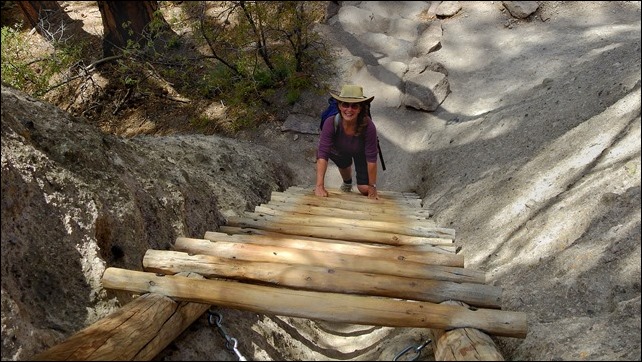
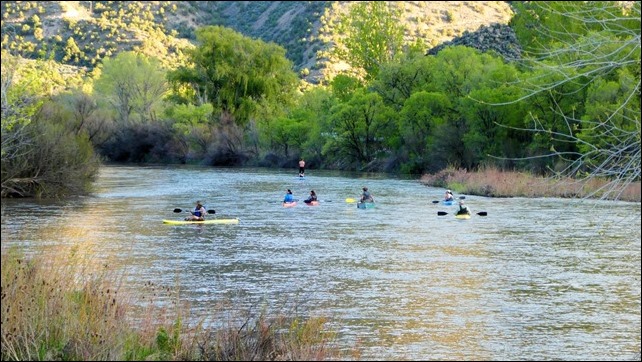
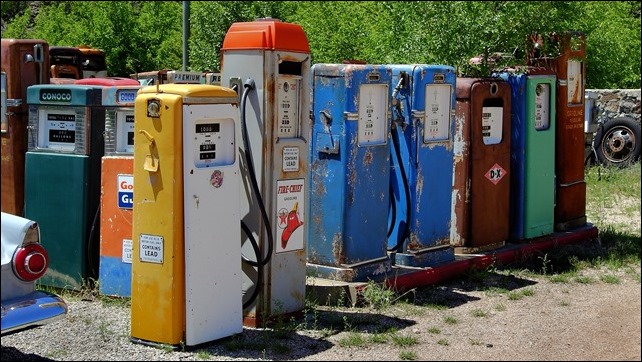
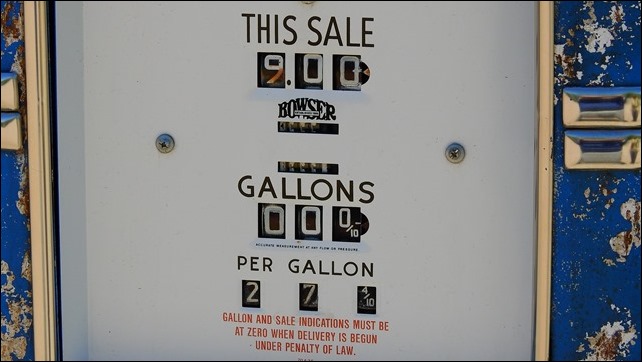
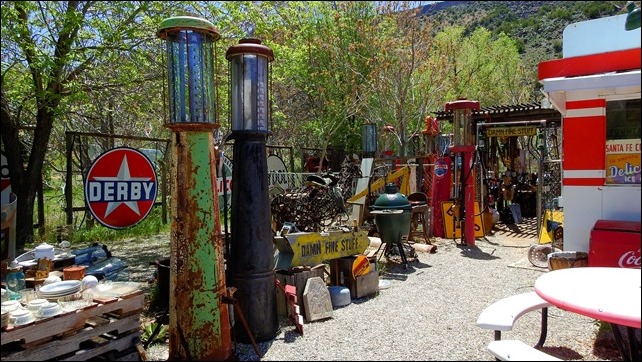

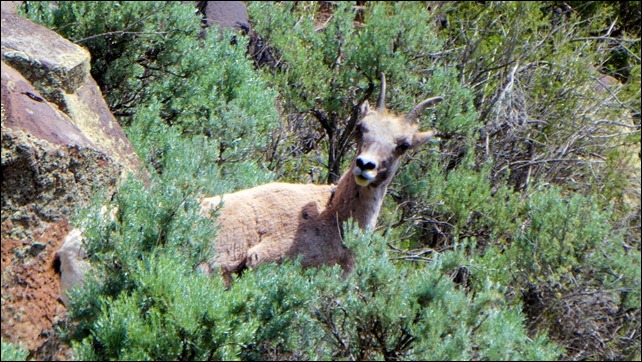
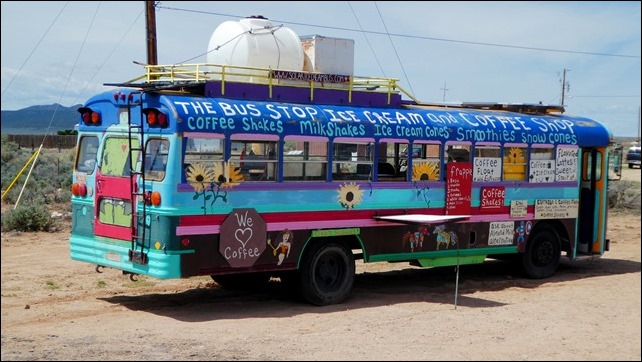
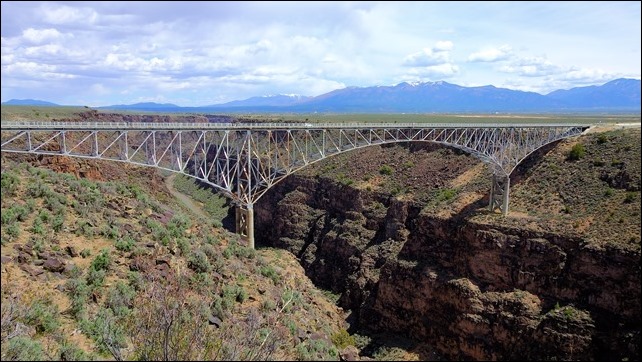
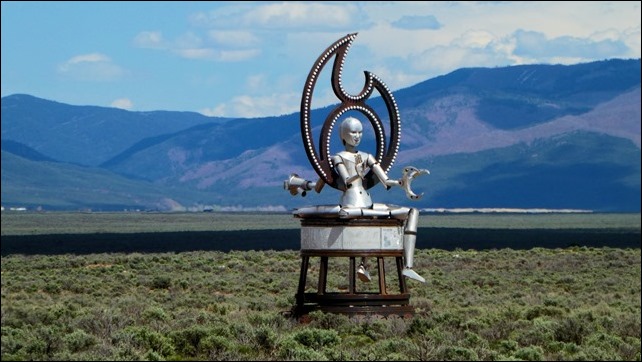
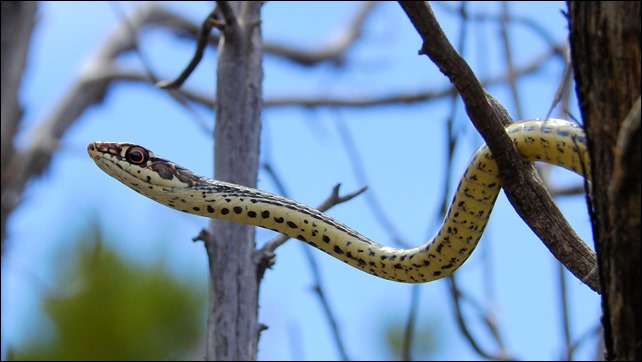
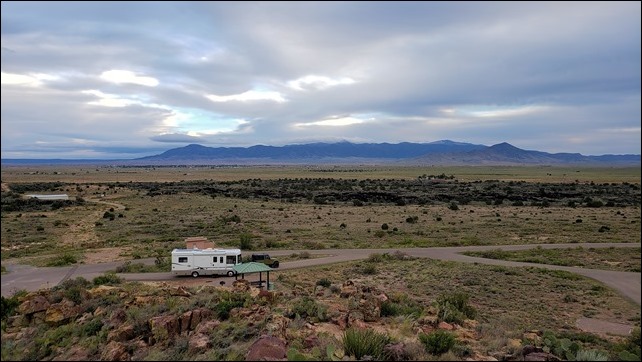
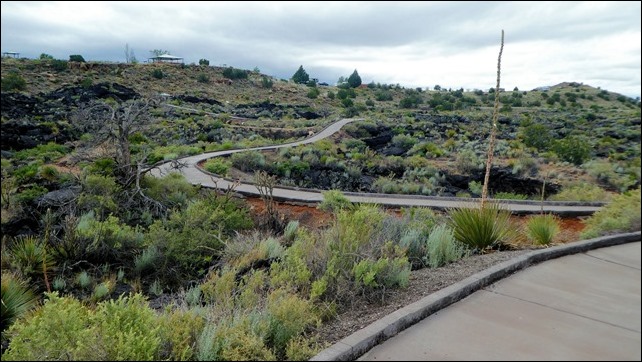
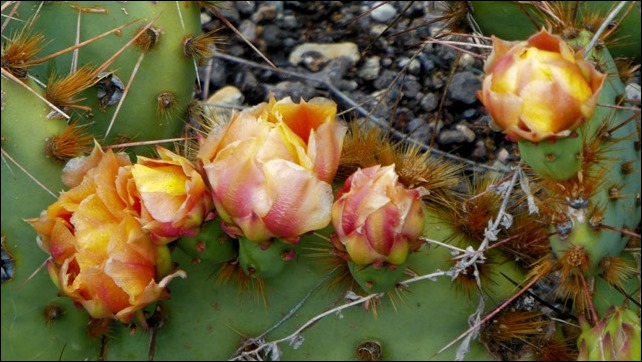
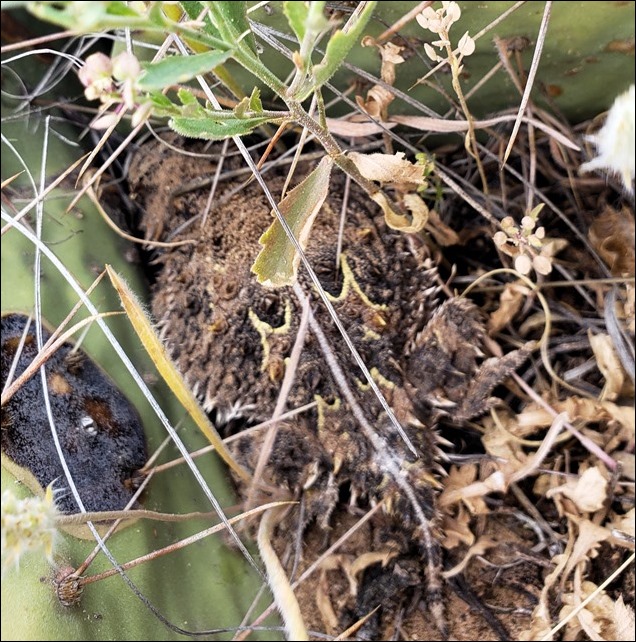
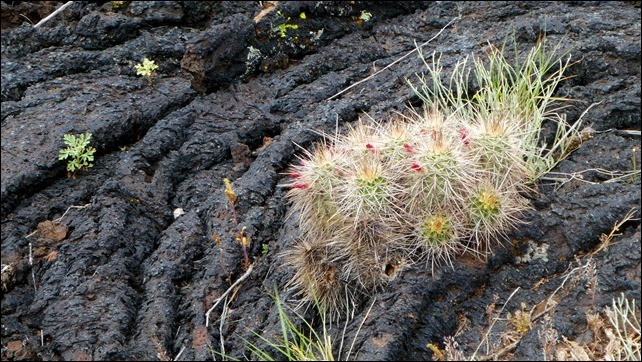
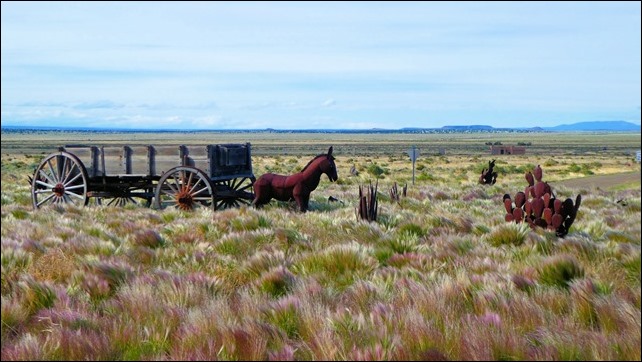
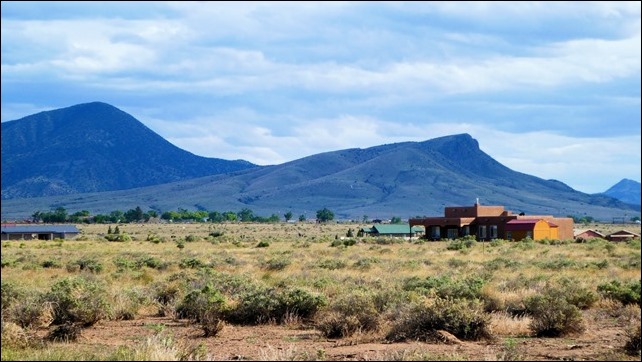
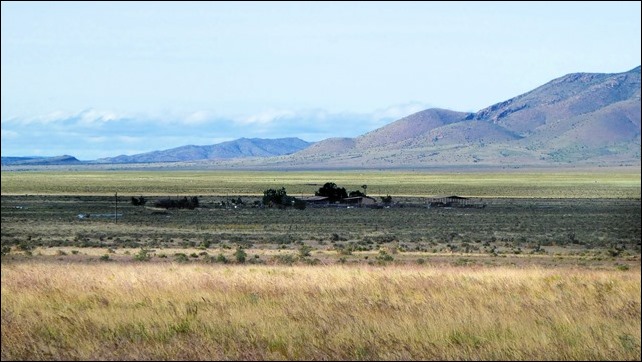
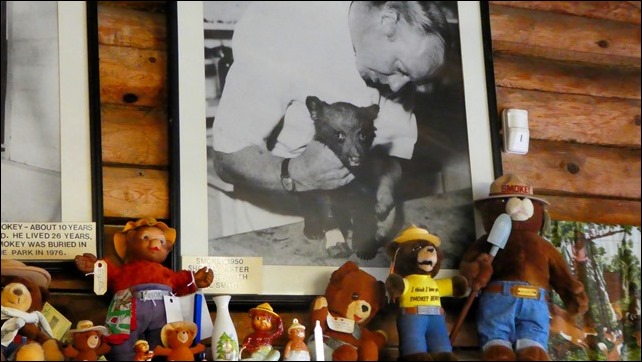
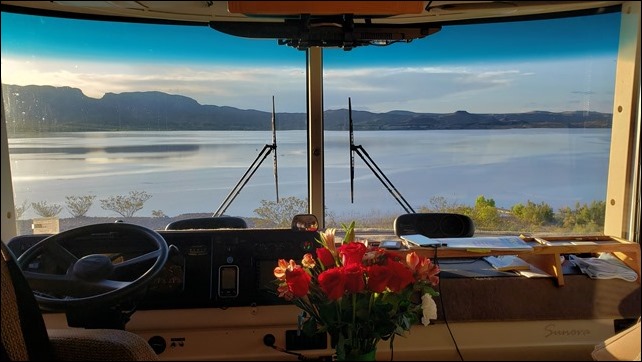
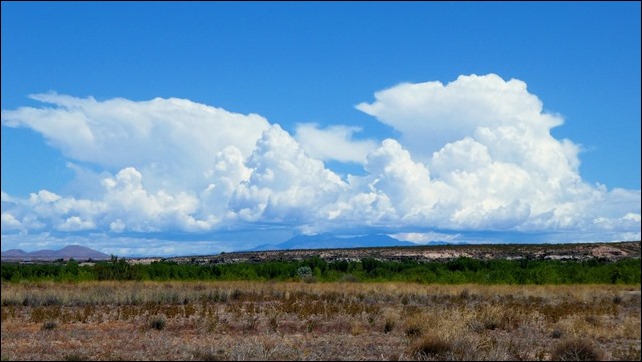
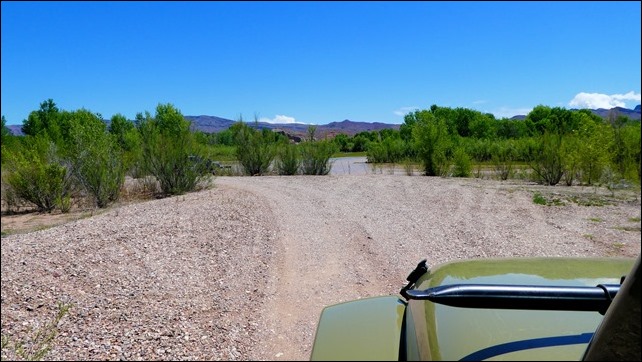
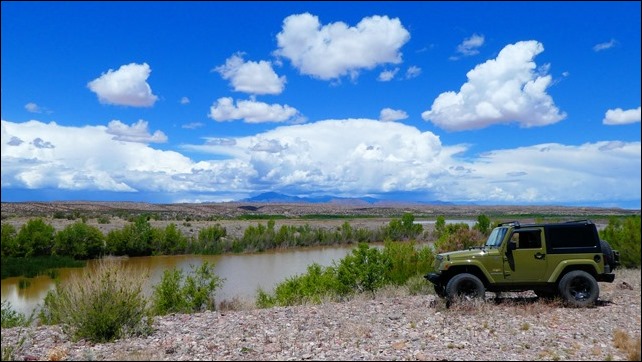
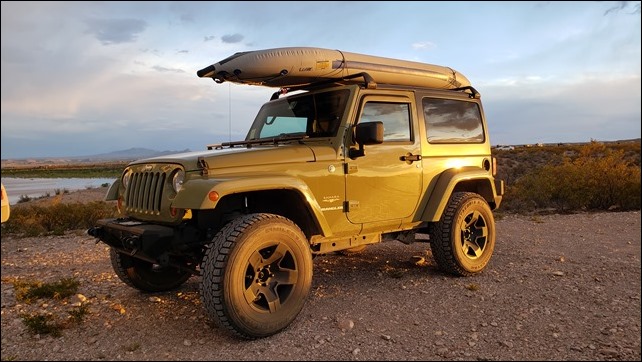
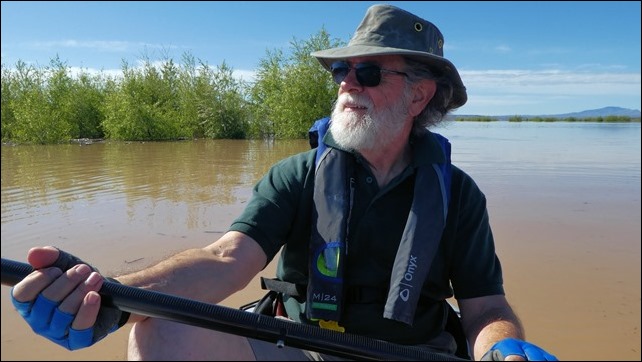
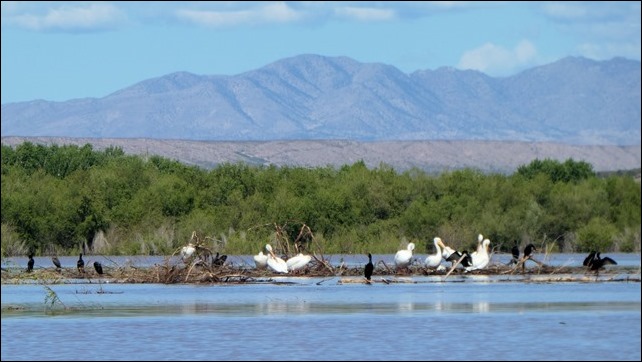
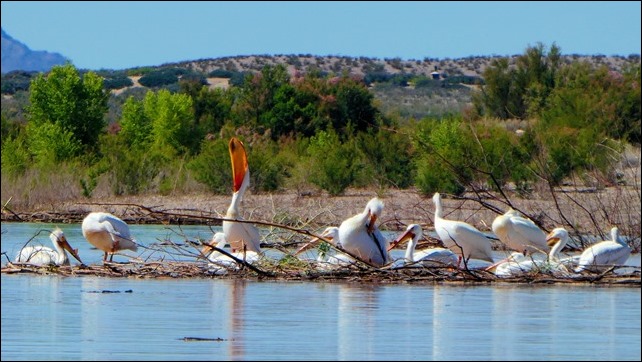
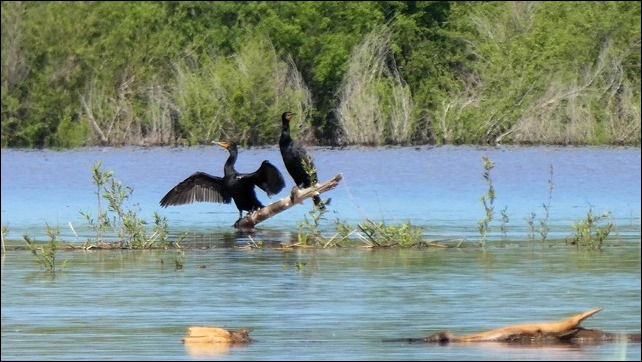
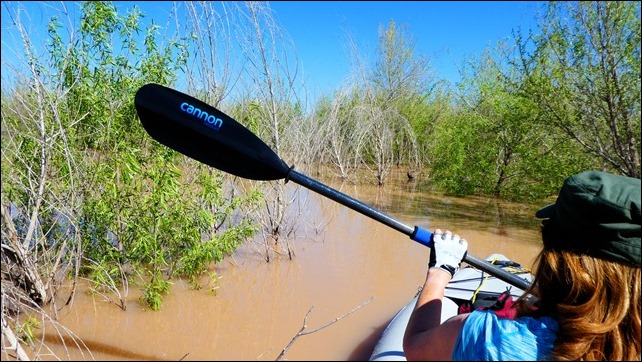
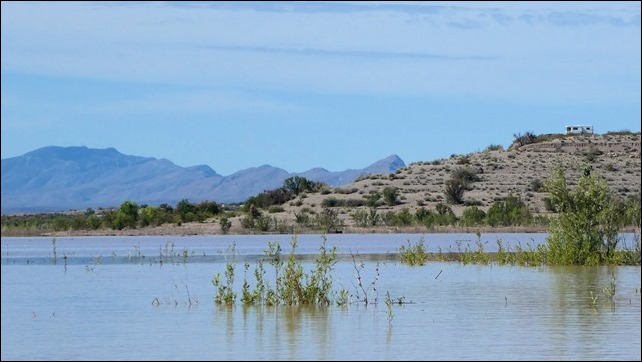
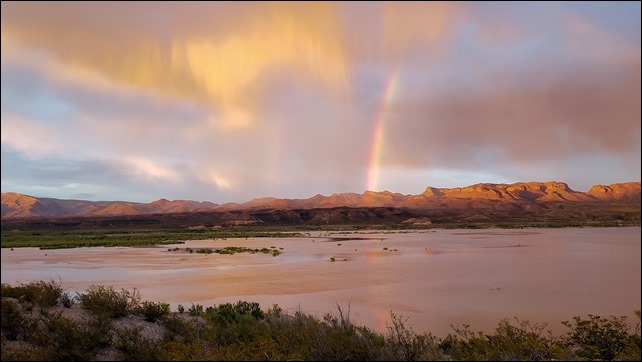
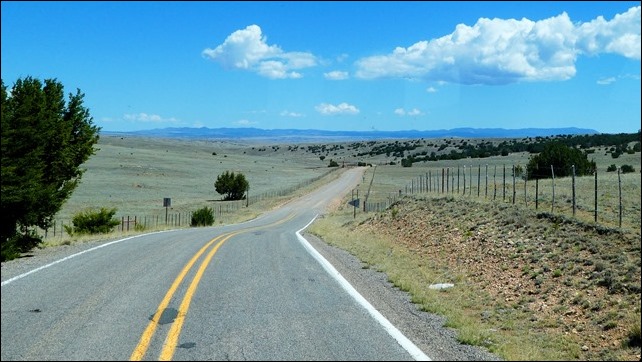
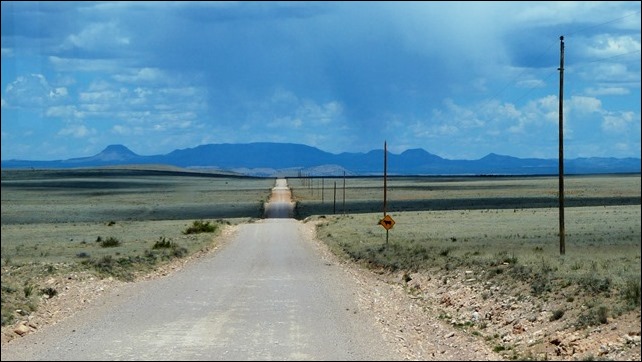
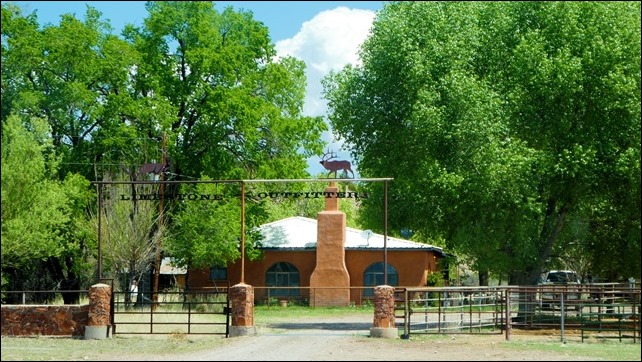
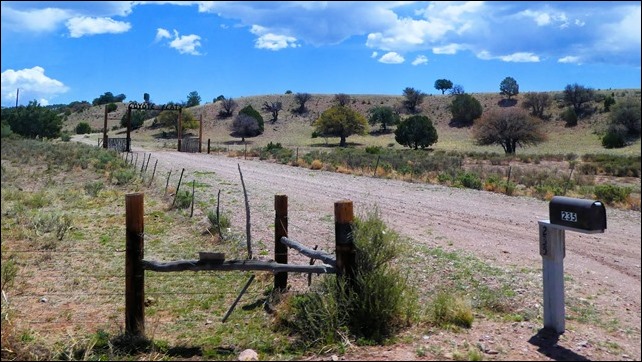
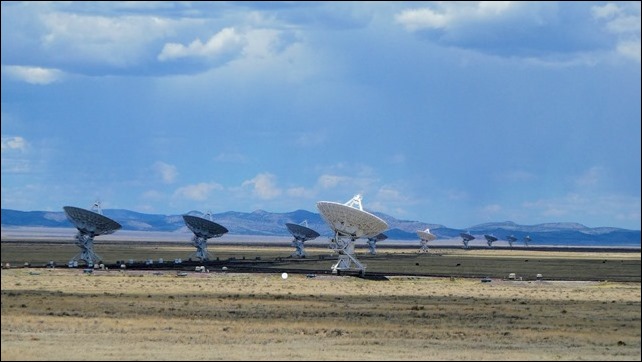
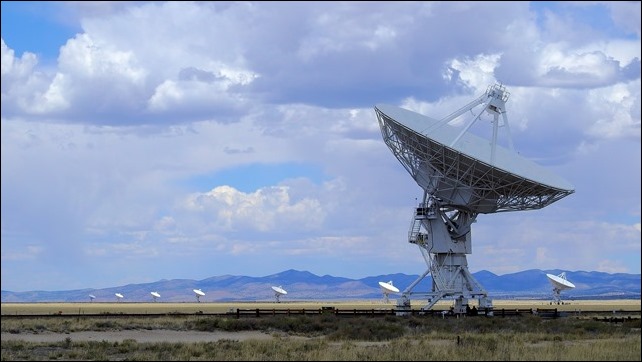
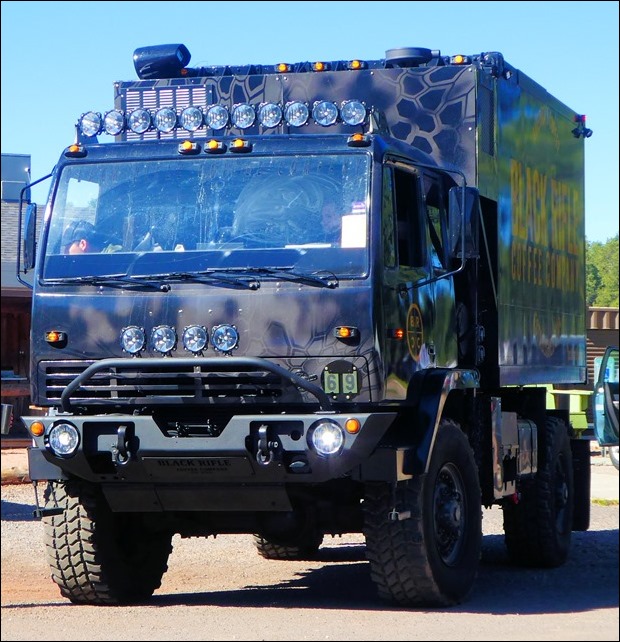
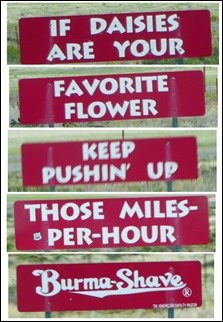
Greg,
I love your posts (about any subject). We explored NW New Mexico three years ago, on our way home to Oregon from our annual “Summer-in-the-Winter” trip. We towed our fifth wheel into Chaco Canyon. Torture! The following summer we broke an axle spring on the trailer. I assumed we had damaged it on that drive into and out of Chaco Canyon. It appears you came in for a day trip from the west, avoiding the 4 1/2 miles of severe washboards just before the park boundary. We did love our stay in the canyon, but won’t be back.
I did google a lot of your references to see where we would like to go on future trips. I also read and “looked” to the end. I love your photos!
I was curious about why you annually attend the Overland Expo. Howie doesn’t make the grade. We camped next to this German couple a few years ago: http://www.monster-worldtour.de He fabricated the vehicle himself. You can read his postings about the process. They told us they would never have made the trip down Africa, if they had known what they were getting in for. They also now live in a converted US ammunition bunker in Germany. He showed us photos of it with windows cut out of the concrete sides. Think concrete quonset hut!
Thanks for your 15 hours of work, sharing, it is always a treat to read anything you write.
Thanks William I really appreciate the praise. As for Howie, stay tuned because he is in for a major upgrade this year.
You’re absolutely right, Howie can not hold his head up around any class of adventure vehicle but that is about to change. By November we expect to have converted him to full blown 4 by 4 with the entire running gear from a Ford F550.
Although Howie will still not be quite in the same league as the Unimogs, he will definitely get us farther in to the remote places that we like to stay, and will be far more comfortable to stay in. We are really looking forward to it.
Hi Greg & Karen, Once again, TOTALLY love your blogs – right to the end! It is fun to relive some of our travels in your amazing country, and appreciate your information which fills in many gaps for us. Much love to both. Elizabeth & John
Hey E&J,
We’d sure like to see you back here again, maybe even do some roaming around together.
How’s your international travel budget?
:o)
Greg, thank you so such an interesting post. I love the pictures. We seem to be slowing down in our travels. My husband is 86 and I am 75 and our trips are closer to home and not too long. Guess that’s why we enjoy your posts. Please keep traveling!
Hi Gerri,
Well, Karin’s 75 and I’m 72, and we’re both hoping to be doing this in our 80’s or maybe even 90’s. Who knows.
I’ll keep blogging as long as we’re able. Thanks for reading.
G.
Thanks for another good read (all the way to the end). Morning coffee and my road atlas for easy reference to your mentioned sites makes for an inspiring morning. I so enjoy your stories. On another note, can I drop my 2013 Itasca 30T off for some of your improvements?😊. Love my rig that is perfect for myself and co-pilot Miss Juice, the loyal and loving black lab. 🐾💃🐾
Hi Marilyn,
You are more than welcome to drop off your Itasca, but I’m sad to say that you’re only next in line to my own projects, which unfortunately seem never to end. Consequently, I can’t promise you any delivery date sooner than the end of the century.
:o)
PS: wait ’til you see what’s coming up this year. A MAJOR reconfiguration. Stay tuned.
Greg,
Your travels are an inspiration and yes, some of us do read to the end! We haven’t made the transition to overloading, but our Winnebago View makes us infinitely more mobile than our old means of travel with a fifth wheel! Would love to see a post about replacing the old Ranger with the JK! (or did I miss it?) I always enjoy your how-to articles as well!
Nice post. I just passed thru NM (Las Cruces, T or C, Sorcorro and PIE TOWN!!). Wished i had taken your route. NM is a special place but not to all. I get comments all the time about my traveling thru NM (from TX to AZ) and they wonder why i bother. If you like roads less traveled this is the place if you stay off I-10 and I-40. Thanks for your much appreciated efforts with the post.
Thanks JR,. City folks tend to have less understanding of this. One of my wife’s friends said to her, “You’ve seen one tree, you’ve seen them all”.
Those who are familiar with my posts know about my love of the back roads. Generally, I use the Interstates only under protest
You are a God send to Linda & I as we can not travel by RV anymore as physical problems so your travels are great for us so please continue when you have time. We had RV’s 1977 – 2016 as the last one was a large truck camper with generator on front carrier on my Chev.2500 heavy duty equipped with a 9’6″ floor space and extended overhang..great rig for sure..I even equipped a portable 8 foot rubber gas hose and male-female couplers to transfer gasoline from under the hood motor are area where a mechanic would check fuel pressure thus no gas cans to carry and 35 gallon truck tank..We managed three sixty day trips from leaving Florida in early spring and headed west usually all different routes and worked our way back to Northern PA. for the summer but still took trips. Being retired Naval Air it was great to see the beauty of America from the ground level..Now we are in our late 70’s and only travel by VW SUV and stay at military base ..lodges & Inns at $60-65.a day no taxes and then just scout and tour. but hiking is a thing of the past..Keep going as one day it will slow down for sure..Thanks again
Bob, thanks for reading and you’re welcome. It’s a pleasure to have folks like you enjoy my ramblings. And yes, we’re in our mid-70’s, and we know our time roaming the earth is not infinite. So far, so good, as they say. We’ll be doing this as long as health permits.
G.
Thanks again for the wonderful road report!!! My favorite part of traveling is learning about the history and people who have lived in those places! That part of our country has an incredibly rich history of peoples that we are still discovering things about!!! Thanks again for your efforts!!
I really enjoy your posts. I’ve been doing a blog of our travels (now in Dawson City, Yukon) and I know how much effort goes into one. I did a long one (although not this long) yesterday and it took me all afternoon. So know people do read and enjoy them.
Cindy,.
thanks so much for enjoying, and for commenting as well. Yes, you’re right about the effort required — I have about 15 hours invested in this post, much of which is photo selection and editing. I used to write a lot more, but discovered again and again that one word is worth a milli-picture
G.